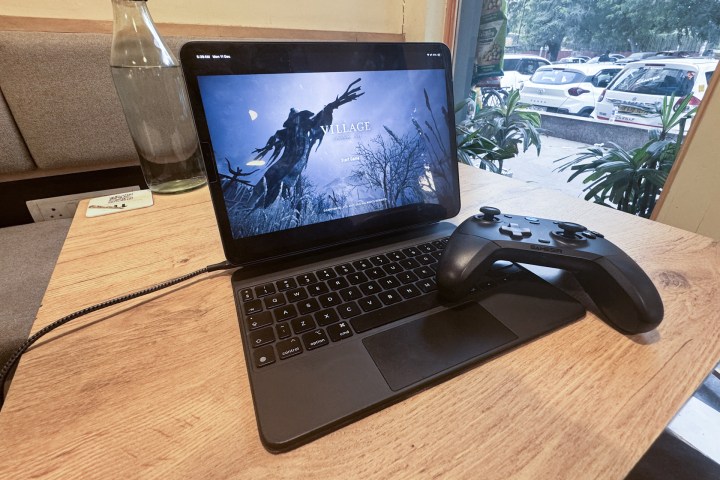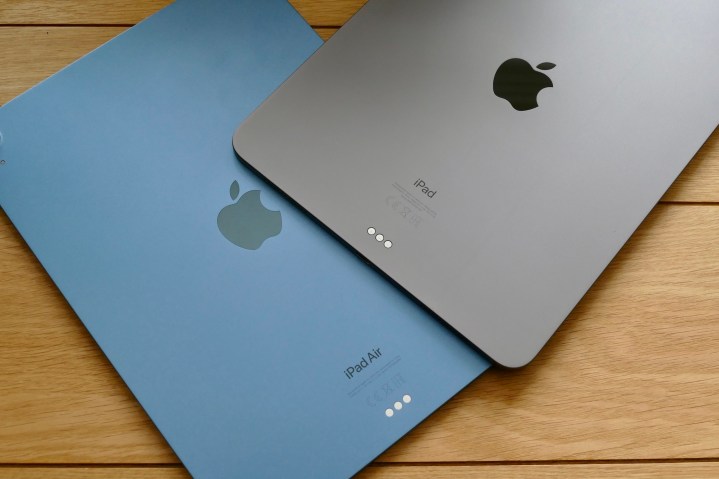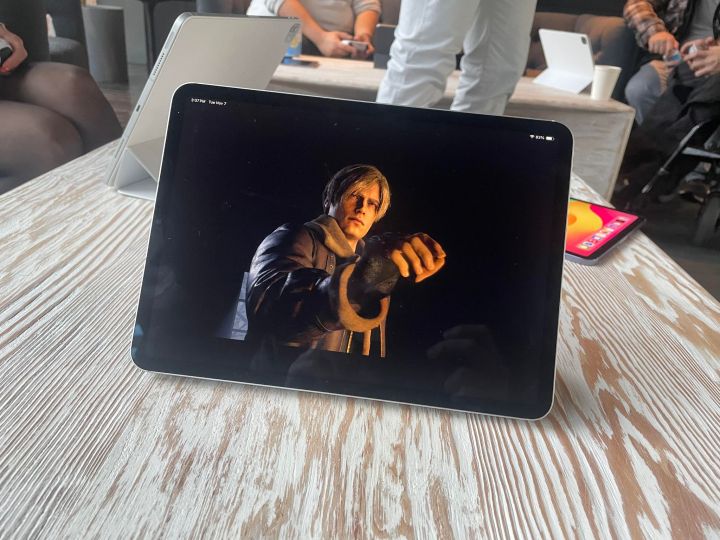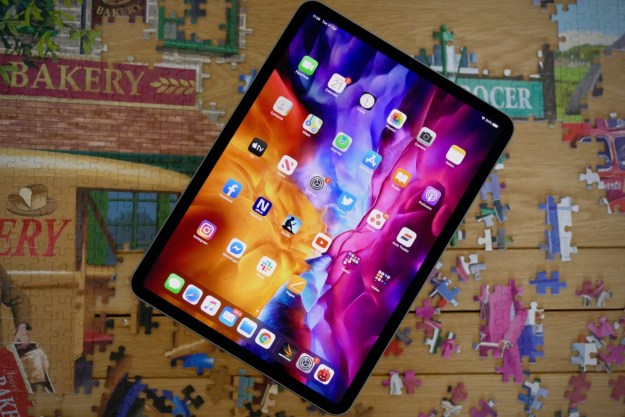
I’ve never had a gaming experience more terrifying than Resident Evil: Village on a mobile device. I began my voyage into the mobile world of horror gaming with the arrival of zombie games like Dead Trigger. It’s still fun but a far cry from the game visuals suited for 2023.
In the past five years, mobile game standards have risen, but they are nowhere near the experience on consoles and PCs. Many factors are to blame here, including the consistently rising standards of gaming engines breaking new grounds for visual fidelity and immersion — all of which are quite taxing on the system resources, especially for mobile silicon.
But serious technical strides are being made. Over the past few years, Apple has talked extensively about the positive performance delta that its M-class silicon offers in the computing world. The chatter was mostly dominated by talk of serious gaming on the Mac.
Surprisingly, the iPad Pro got a desktop-class silicon upgrade, and naturally, Apple started bringing fittingly demanding apps like Final Cut Pro and Da Vinci Resolve to the tablet. Games were next. But I was not prepared for the sheer excellence of execution.

Lately, I have kept myself preoccupied with titles in the Apple Arcade library and have been impressed by the added dash of visual finesse and mechanical fluidity they offer. The latest games in the Teenage Mutant Ninja Turtles and Castlevania series have been particularly enjoyable.
However, they pale — dramatically — compared to Resident Evil: Village on the iPad Pro. Two familiar coffee shop coworking faces who tried Resident Evil: Village on the Apple slate at my insistence were blown away by the execution. The experience of Digital Trends’s Giovanni Colantonio was not too different.
The tech behind the scene

The biggest reason is how beautifully Apple — and Capcom — have ported the horror game to the iPadOS platform. It was all made possible courtesy of the Game Porting Toolkit and the Metal API, which powers hardware-accelerated graphics experiences in video games on Apple silicon.
Think of the former as a tool of the same significance as Rosetta 2, one that allowed developers to port their x86-based apps running on Intel processors to the ARM flavor championed by the M-series silicon inside the Macs. To bring AAA games to the Mac, Apple introduced the Game Porting toolkit, an emulation system that allows developers to run their unmodified Windows games and assess how they will run on an Apple platform.
It’s a multistep process where developers have to compile the shader behavior for translation, handle the graphics rendering subsystems, and then tackle the audio and

Of course, Apple promises better performance if you bring games natively to its platform, but it would take some time before major developers take that bait and develop original games solely for Macs and iPads with Apple silicon. Once the porting is over, Metal (currently in its third generation) kicks into action and introduces its in-house upscaling goodness.
In the background, it takes fundamental routes for temporal and spatial upscaling with a tech called MetalFX. When you play AAA games ported to Apple platforms, it materializes as two quality presets: Quality and Performance. In Resident Evil: Village, you can make your pick depending on how you prefer your gameplay experience.
What’s it like gaming on an iPad?

Capcom’s biggest success at porting Resident Evil: Village to the iPad is that the graphics feel as close to what you get on a current-gen console or fairly powerful
Of course, there is some learning curve here before you land on the right graphics settings to strike the best balance between visual quality and performance. Using external software, I noticed that the game comfortably manages near-60 fps and near-30 fps performance, depending on your graphics preferences.
The key deciders here are the two Metal FX upscaling presets. But with a bit of tweaking around the shadow, lighting, and noise settings, and most importantly, the resolution, you can jump the frame rate tiers.
Talking about screen resolutions here, keep in mind that the iPad Pro is not the ideal format for playing AAA games. Capcom’s horror survival game is no exception. Thick black borders at the top and bottom persistently (read: distractingly) show details such as connectivity status, date, time, battery percentage, and more.
For the best visual quality experience around the 30 fps mark, I kept the resolution tied to the iPad Pro’s native numbers and MetalFX set to quality. Texture quality, mesh, shadow, and volumetric lighting quality were set to medium. But if you prefer the smooth 60 fps experience, set the MetalFX upscaling to performance, bring the resolution down a notch, set all texture presets to medium, and disable occlusion, scattering, and depth of field.
Save for the scenarios where you run into enemies and have to simultaneously deal with movement and offense, the frame rate at the MetalFX performance preset consistently stays above the 50 fps mark. With graphics settings cranked up, you won’t come across many dips below the 26 to 30 fps threshold. The game does offer a 120 fps option, but the hit on visual details is not worth the gameplay fluidity here.
In the image below, notice the details on the tree texture visible through the window. This is how details are rendered at MetalFX Quality preset with the frame rate set to 30 fps preset.

Now, the image below depicts the reduced details when you play Resident Evil: Village at the MetalFX performance preset and frame rate targeting the 60 fps maximum.

But if you seek to dig into the signature horror world of Resident Evil, playing at the “regular” 30 fps mode while making the best of graphics settings available is the best option. You need to experience those dark shadows, object-aware lightning, and surface detailing to soak in the gore of a zombie-afflicted world.
Resident Evil: Village on the iPad Pro doesn’t cut any corners when serving just that. Another aspect that surprised me was the thermal optimization. After 30-minute sessions each at the quality and performance modes, the temperature values never exceeded the 40-degree Centigrade mark.
The iPad Pro definitely feels warm in your hands if you’re using the touch-screen controls, but not enough that you would want to put it away for a cooldown phase. That’s particularly impressive, considering the iPad Pro’s tightly packed chassis and the lack of a fan inside. But if you’re coming from a current-gen console or a
Reflections over dynamic surfaces like water are still tricky to execute on a mobile platform. The same applies to depth rendering. Then there’s the issue of

Compared to the native experience of playing Resident Evil: Village, the iPad experience certainly feels flatter. Aside from visual niceties, it’s easy to notice frame drops, especially when the protagonist goes from wandering in the snow-capped cursed village to a high-stakes situation where they need to switch between weapons, evade, attack, and run at the same time.
As far as battery drain goes, it varied between 12 to 18 minutes for an average 30 min session. Your mileage may vary depending on the graphics preferences. A friend of mine tried the game on their iPad Air with the M1 silicon inside and recounted similar battery drain figures, as well. But the iPhone 15 Pro Max is an entirely different ballgame, owing to its noticeably smaller battery and the constrained situation for thermal management.
The ecosystem conundrum

It’s important to put the iPhone in context here. The
But if you look at it, the iPad Pro comes out as an enlarged-screen variant of the iPhone in the perspective of AAA games like both the Capcom titles mentioned above. The dial stops at the screen. Or, to put it more accurately, on-screen controls. On an iPhone, well, they are cramped, but at least it’s relatively light and compact.
The iPad Pro is a slate. It’s not just heavier but notably larger. You can’t possibly use it with a single hand for playing games where the buttons are separated across two halves of the screen. In addition to the warmth of the metal chassis, you really feel the fatigue on your hands after playing the game.
That makes controllers mandatory for enjoying Resident Evil on the iPad Pro. Those recommended by Apple cost north of $70, which is quite some financial overhead atop the game’s $40 asking price and the DLC worth $20. All that for playing a game that is clearly not superior to the experience you get on consoles or PCs for the same price.

The asking price also feels steep when solutions such as Xbox Remote Play exist. You get to enjoy the “real” Resident Evil: Village on the phone in its non-Applefied format without any restrictions on the graphics fidelity and raw performance.
Where is Magic Keyboard support?
And did I tell you that there is no official support for the Apple Magic Keyboard to be seen here? Only the trackpad works for cursor movement, but that, too, has no role when controlling the in-game characters. Yes, the buttons are small compared to an average mechanical keyboard, but why not add support for it when you already offer one?
Plus, not every game that arrives on iPadOS down the road will be as button-intensive for combos and controls as Resident Evil: Village. I hope that Apple nudges Capcom — and other partner studios — to address the situation here.
The accessories situation

On one hand, Apple is trying to sell the idea that the iPad — or at least the Pro models — is nothing short of a computer. There’s even a well-made keyboard accessory to make a solid case for Apple’s argument.
But at the same time, studios like Capcom are not bundling support for mouse and keyboard input for iPhones and iPads. At least that’s the case for the two Resident Evil series games it has ported to Apple’s mobile platforms. Mind you, Capcom is the one shouldering Apple’s dreams of top-tier gaming on mobile devices at the moment.
That means you either need to live with cramped on-screen controls that take away all the game’s visual appeal or fork over a lot of cash for a good controller. From what I can surmise, the only legitimate way to play AAA games on Apple’s smartphones and tablets is to spend extra on a controller. If you’re picky about latency and the tactile feel of buttons, you need to spend good money on a decent-quality controller.
An uncertain glimpse into the future

My overarching takeaway here is that playing Resident Evil: Village on an iPad (and an
All of this is a mighty showcase of Apple’s technical prowess. If you are someone who doesn’t carry a laptop or owns a console but has only dreamt of a day when the iPad can fill that gap for you, Resident Evil: Village and
It’s a peek into the future. A very limited one, mind you, because there are only a limited number of games ready to shine on the iPad. If you already own an iPad, dive right in and witness how AAA gaming is finally possible on a mobile device natively. But if you’re a PC or console purist, well, let’s just say that you are good where you are.
Editors' Recommendations
- Apple is about to do the unthinkable to its iPads
- Apple accidentally revealed a big iPad Pro display upgrade
- You may have to wait a while longer for new iPads
- I’m worried about Apple’s new iPads
- Apple may announce new iPads next month. Here’s everything we expect




